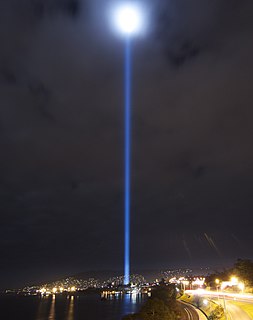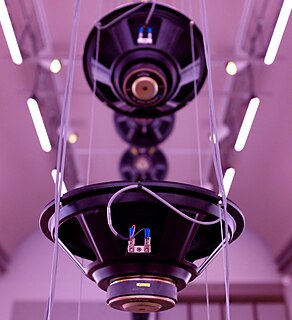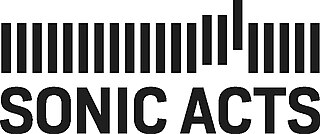Electroacoustic music is a genre of Western art music in which composers use technology to manipulate the timbres of acoustic sounds, sometimes by using audio signal processing, such as reverb or harmonizing, on acoustical instruments. It originated around the middle of the 20th century, following the incorporation of electric sound production into compositional practice. The initial developments in electroacoustic music composition to fixed media during the 20th century are associated with the activities of the Groupe de recherches musicales at the ORTF in Paris, the home of musique concrète, the Studio for Electronic Music in Cologne, where the focus was on the composition of elektronische Musik, and the Columbia-Princeton Electronic Music Center in New York City, where tape music, electronic music, and computer music were all explored. Practical electronic music instruments began to appear in the early 1900s.

Ryoji Ikeda is a Japanese visual and sound artist who currently lives and works in Paris, France. Ikeda's music is concerned primarily with sound in a variety of "raw" states, such as sine tones and noise, often using frequencies at the edges of the range of human hearing. The conclusion of his album +/- features just such a tone; of it, Ikeda says "a high frequency sound is used that the listener becomes aware of only upon its disappearance". Rhythmically, Ikeda's music is highly imaginative, exploiting beat patterns and, at times, using a variety of discrete tones and noise to create the semblance of a drum machine. His work also encroaches on the world of ambient music; many tracks on his albums are concerned with slowly evolving soundscapes, with little or no sense of pulse.
David Chesworth is an Australian-based interdisciplinary artist and composer. Known for his experimental and at times minimalist music, he has worked solo, in post-punk groups, electronic music, contemporary ensembles and experimental performance. Together with Sonia Leber, Chesworth has created a series of large scale installation and video artworks, such as Zaum Tractor included in the 56th Venice Biennale (2015) and This Is Before We Disappear From View commissioned by Sydney Biennale (2014).
The Biennale of Sydney is an international festival of contemporary art, held every two years in Sydney, Australia. It is the largest and best-attended contemporary visual arts event in the country. Alongside the Venice and São Paulo biennales and Documenta, it is one of the longest running exhibitions of its kind and was the first biennale to be established in the Asia-Pacific region.

Michael Shaowanasai is a Thai-American artist and actor who lives in Bangkok. His works includes performance art, photography, video, film and installations.
Electrofringe is a presenting platform for experimental electronic and technology-based art in Australia. Electrofringe is a non-profit arts organisation and annual festival. As of May 2020 the Artistic Director is Ellen Formby, General Manager is Patrick Diment and Marketing and Communications Manager is Sally Lewis.
Sonic Arts Network was a UK-based organisation, established in 1979, that aimed to enable both audiences and practitioners to engage with the art of sound through a programme of festivals, events, commissions and education projects. Its honorary patron was Karlheinz Stockhausen.

Raven Chacon is a Diné artist known as a composer of chamber music, as well as a solo performer of noise music. He was born in Fort Defiance, Navajo Nation, Arizona, United States).
Richard Chartier is a sound/installation artist and graphic designer. Chartier works in reductionist microsound electronic music, a form of extreme minimalism in which the music is sometimes very quiet, sometimes very sparse, often both.
Semiconductor is UK artist duo Ruth Jarman and Joe Gerhardt. They have been working together for over twenty years producing visually and intellectually engaging moving image works which explore the material nature of our world and how we experience it through the lens of science and technology, questioning how these devices mediate our experiences. Their unique approach has won them many awards, commissions and prestigious fellowships including; SónarPLANTA 2016 commission, Collide @ CERN Ars Electronica Award 2015, Jerwood Open Forest 2015 and Samsung Art + Prize 2012. Exhibitions and screenings include; The Universe and Art, Mori Art Museum, Tokyo, Japan, 2016; Infosphere, ZKM, Karlsruhe, 2016; Quantum of Disorder, Museum Haus Konstruktiv, Zurich, 2015; Da Vinci: Shaping the Future, ArtScience Museum, Singapore, 2014; Let There Be Light, House of Electronic Arts, Basel 2013 ; Field Conditions, San Francisco Museum of Modern Art, 2012; International Film Festival Rotterdam, 2012; New York Film Festival: Views from the Avant Garde, 2012; European Media Art Festival, 2012; Worlds in the Making, FACT, Liverpool 2011 ; Earth; Art of a Changing World, Royal Academy of Arts, London, 2009 and Sundance Film Festival, 2009.

The Vladivostok Biennale of Visual Arts is an international festival of contemporary and modern visual art, held every two years in Vladivostok, Russia. The first Biennale was held in April, 1998 in Vladivostok. Then there was presented theatre art only, but after that first Biennale there were made a decision to move beyond the theatre Biennale and turn it into Biennale of visual arts. The founder and organizer of the Vladivostok Biennale is Vladivostok city’s administration of Primorsky Krai. An event is sought to rapprochement of Russian and Asia-Pacific region’s culture.
Caleb Kelly is a curator, author and educator from New Zealand currently based in Sydney, Australia. His particular area of interest is sound and noise works by artists.

Berlin Atonal is an annual festival for sonic and visual art in two distinct stages. It first took place between 1982 and 1990, relaunching in 2013 under new direction and continuing to the present day. The festival presents contemporary, interdisciplinary projects at the intersection of sound art, visual and media art, installation and performance, with an emphasis on commissioned work and world premieres. Apart from the annual event, Berlin Atonal has presented other satellite events such as The Long Now, New Assembly in Tokyo, and has collaborated with Deutsches Symphonie-Orchester, Dark Mofo and Berliner Festspiele.
Hiromi Tango is a contemporary artist working predominantly with textiles in installation and performance art. Tango was born in 1976 on the Japanese island of Shikoku. Tango graduated from a Bachelor of Arts at the Japan Women's University in Tokyo, Japan. The artist lives and works in Tweed Heads, Australia with her partner artist Craig Walsh.

Sonic Acts is an organisation for the research, development and production of works at the intersection of art, science and theory. It also commissions and co-produces new works, often in collaboration with international festivals, arts organisations, funders and other partners.

Shiro Takatani is a Japanese artist. He currently lives and works in Kyoto. Co-founder and visual creator of the group Dumb Type since 1984, he also became artistic director of the group from 1995 and also started an active solo career in 1998.
Peter Callas is an Australian artist, curator and writer, particularly known for his pioneering video art using computer graphics made with the Fairlight CVI.
Joan Grounds is an American-born artist. She has been exhibiting in Australia and internationally from 1967. Her solo and collaborative art work is held in the National Gallery of Australia (ceramics), the National Gallery of Victoria and in the Powerhouse Museum of Arts and Applied Sciences (ceramics). Her hybrid practice incorporated ceramics, sculpture, sound art, film and performance art.
Video Hiroba was a Japanese video art collective founded as a result of the first Japanese Video Art symposium and exhibition, Video Communication/Do it Yourself Kit, organised by Michael Goldberg, Nakaya Fujiko and Yamaguchi Katsuhiro. Members of Video Hiroba were interested in exploring the possibilities and production of video as a form of mutual communication technology in the public sphere.






